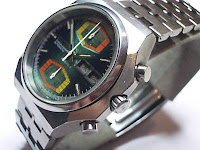(All photos - Sony DSC-F717)
This movement type (the 7T59) was only produced between 1991 and 1993. I have no idea what the production quantity was, but although it was encased in a variety of styles, it must have been one of Seiko's lowest outputs.
The technology is incredible. As far as I can determine - and I certainly welcome corrections - this is the only quartz analogue chronograph to (a) have nine hands and (b) give timing to 100th. of a second. No other analogue has that capability.
So for the technology alone, this movement became a "must have" for me.
I was not leaning towards one particular style - there are a variety to be had, but as the watch is pretty rare on the "for sale" sites, one takes what one can get!
So when this one popped up - in France - I was very enthusiastic because I really liked the combination of very dark gunmetal finish to the stainless-steel case and bracelet coupled with the gold-tone highlights. To my eyes it makes a very attractive combination - not overly utilitarian yet still with slight "dressy" characteristics.
The watch is not pristine - far from it.
This has been used as a regular wrist-band at some stage in it's past life, evidenced by the small ding on the bezel at the 6:30 point and some similar wounds on the case-back.
At least the crystal is clear of any gouges or major scratches - there are some fine scratches on it but nothing that is significant.
The bracelet is the tell-tale to the fact that this watch was a favourite. There is wear on the section that would sit under the wrist and make contact with desks and tables and bench-tops etc. For me, this just adds to the patina and provides some personality to the watch.
This is so comfortable to wear - I hardly know it's on my wrist - and the time-keeping is very accurate.
I love it and, when I don't wear it, the 7T59 holds pride of place on my shelf.
The technology is incredible. As far as I can determine - and I certainly welcome corrections - this is the only quartz analogue chronograph to (a) have nine hands and (b) give timing to 100th. of a second. No other analogue has that capability.
So for the technology alone, this movement became a "must have" for me.
I was not leaning towards one particular style - there are a variety to be had, but as the watch is pretty rare on the "for sale" sites, one takes what one can get!
So when this one popped up - in France - I was very enthusiastic because I really liked the combination of very dark gunmetal finish to the stainless-steel case and bracelet coupled with the gold-tone highlights. To my eyes it makes a very attractive combination - not overly utilitarian yet still with slight "dressy" characteristics.
The watch is not pristine - far from it.
This has been used as a regular wrist-band at some stage in it's past life, evidenced by the small ding on the bezel at the 6:30 point and some similar wounds on the case-back.
At least the crystal is clear of any gouges or major scratches - there are some fine scratches on it but nothing that is significant.
The bracelet is the tell-tale to the fact that this watch was a favourite. There is wear on the section that would sit under the wrist and make contact with desks and tables and bench-tops etc. For me, this just adds to the patina and provides some personality to the watch.
This is so comfortable to wear - I hardly know it's on my wrist - and the time-keeping is very accurate.
I love it and, when I don't wear it, the 7T59 holds pride of place on my shelf.


















































